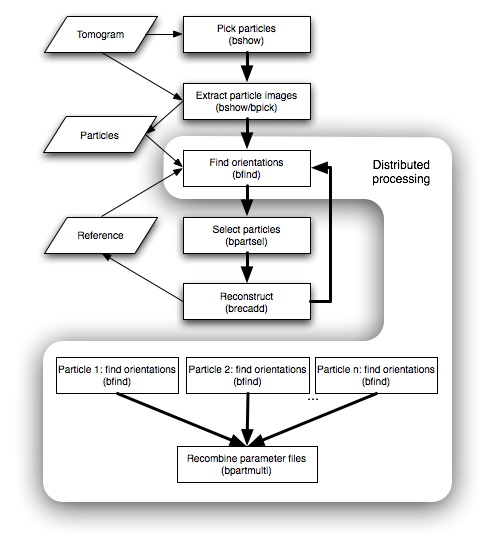3D Single Particle Analysis

1. Picking 3D volumes from an image
Go here for picking particles in bshow. The output is a set of particle images and a parameter file with the particle file names and parameters.
2. Preparing for alignment
Alignment requires some information, such as symmetry or a template/reference.
Prerequisites:
- Template or reference
- Mask (optional)
Template
Templates are
generally derived from atomic coordinates or other 3D reconstruction
techniques (such as traditional SPA). Here it is important to get the
sampling correct and consistently encode it into the image headers. The
first task is to prepare the reference to the same pixel size and image
size as the particles in the extracted volumes, and to orient it
correctly according to its symmetry. This is a topic for another
tutorial and I'll assume this has already been done with the reference.
Reciprocal space mask
The program bfind uses a brute-force cross-correlation search through
the asymmetric unit of the reference to find the orientation of an
extracted particle. The cross-correlation can be used with a reciprocal
space mask, to eliminate the contribution of missing data, such as the
missing wedge in the case of tomography. To create such a mask with a
size of {70,70,70}, a wedge defined by the tilt axis rotated by 45 degrees from the x-axis, tilt angles {-60,60}, and
wrapped around for reciprocal space, use the following:
bmissing -v 7 -create 70,70,70 -wedge 45,-60,65 -wrap mask.pif
Note that the origin of this mask must be {0,0,0}, the default for Fourier transforms.
3. Orientation determination
The orientation of each particle is determined individually because it requires long processing times, depending on the angular step sizes used. This requires the specification of a selected particle in the parameter file referencing the particle image files. A particle can be selected by its reconstruction ID (-recid) and particle number (-image), or by a number in the selection column. The latter is the easiest to do, and all the selected particles in the parameter file can be numbered sequentially:
bpartsel -v 1 -sets 1 -output part_selection.star tomo_particles.star
The orientation of each particle is then determined individually:
bfind -v 1 -select 9 -global 2 -mode refine -symmetry D5 -angle 3 -resolution 40,200 -Template ref.map -Mask mask.pif -output p10.star tomo_particles.star
The -global option specifies a global search within the asymmetric unit with a binning kernel of size 2. This is followed by a refinement around the best view without binning. The -angle option gives the angular step size for all 3 Euler angles for the global search only, where alpha is the rotation angle step around the view vector, and phi and theta are calculated to cover the asymmetric unit evenly. The resolution limits (units in angstroms) are imposed to avoid high resolution noise and low resolution features from dominating the cross-correlation. All images must be the same size (template, mask and particles). The output parameter contains the particle orientation and FOM.
Additional output options can be used:
-particle <file>: this outputs the transformed particle to a new file. The orientation in the parameter file is now set to {0,0,1,0} to indicate it is in the same frame of reference as the template.
-newtemplate <file>: this outputs the transformed template to a new file.
One set of parameters is obtained for each particle, and the all the parameter files need to be merged into a single parameter file:
bpartmulti -v 7 -merge -out tomo_part_aln.star p*.star
(bfind can also be run specifying the particle image directly, but then care must be taken to provide the correct parameters for the output parameter file)
4. 3D averaging
The program brecadd uses the orientations specified in the parameter file, transforms the particle images, and adds them into an average:
brecadd -v 7 -symmetry D5 -out tomo_part_avg.star -average tomo_part_avg.map -fom tomo_part_var.map tomo_part_aln.star